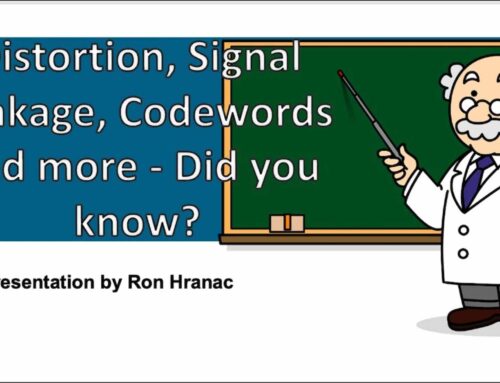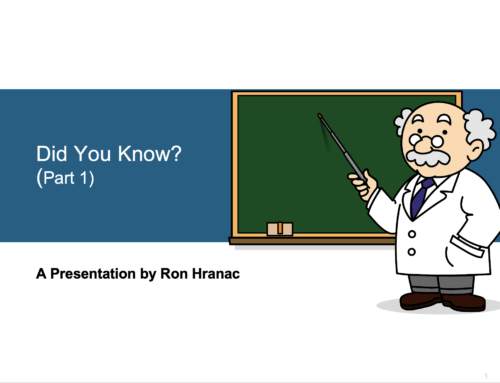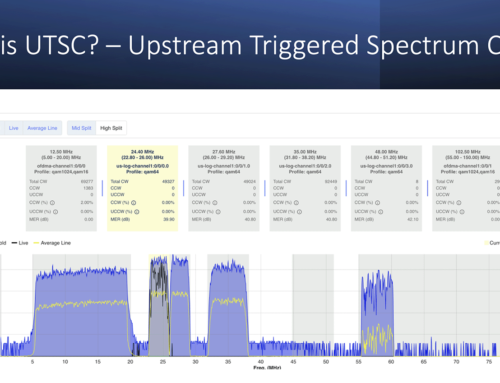DOCSIS 101
Over the past several years of training people on troubleshooting DOCSIS® networks and explaining how DOCSIS cable modems and CMTSs work, I have been asked numerous times – “Why don’t you write a book on this?” You see, there is no definitive book, guide or manual that explains the Data-over-Cable Service Interface Specification (DOCSIS) other than the several hundred page specification itself. While I recommend that everyone interested in fully understanding DOCSIS read the specification located on the CableLabs website at www.cablelabs.com, I will warn you that it can be very technical. So what I will do over the next several posts on this DOCSIS 101 blog is provide a boiled-down version of the operation of the DOCSIS specification, i.e. how cable modems connect to the cable modem termination system (CMTS) and transmit data. While I will provide quite a bit of technical detail, I will try to communicate it in such a way that a Ph.D is not required to comprehend it.
First, some disclaimers. DOCSIS® is a registered trademark of CableLabs. Founded in 1988 by cable operating companies, Cable Television Laboratories, Inc. (CableLabs®) is a non-profit research and development consortium that is dedicated to pursuing new cable telecommunications technologies and to helping its cable operator members integrate those technical advancements into their business objectives. CableLabs has been the cornerstone for the development of many standards in the cable telecommunications industry, most notably DOCSIS and a number of standards which have extended the capabilities of the DOCSIS specification.
Tune in for my next post where I will describe the radio frequency (RF) spectrum allocated to DOCSIS cable modem communication and how this allows the data to be transported from the cable operator to your home or office.
Upcoming events can be seen under Broadband Events. Previous events can be seen under the blog.
- If you are watching this on youtube please hit the subscribe button!
- Let us know what you think and remember to share!
- You can find slides at the bottom of the page and some on slideshare.
- Find out about events or articles by following us on Twitter, LinkedIn or Facebook too.
Also available on iTunes, Google Podcasts, Spotify, vurbl see podcasts “get your tech on”.





Hey man I just wanted to say thanks for taking the time to create something worth my time to read. I am all over the internet and I see so much useless junk that is just created for the sake of putting something new on their site . It takes devotion to make good stuff, thanks for caring.
Thanks for making this guide. It’s very interesting quality stuff.
Best regards,
Jeroen
I’ve been surfing the net around and never found anything better than this website about DOCSIS and Cable Modem . I’m totally amazed with your dedication and passion. Thumbs up for a job well done.
Thanks for the feedback.
Please give basic lesson of meaning for Upstream(US) and downstream(DS), we bought cable modem by Zoom( Docsis 3) and after installing it takes 3 to 5 min to get connected. Before it was connecting in 2 min, We did ,what Comcast technical support told us to do, to disconnect cable, computer and router few seconds with no change, thanks.
Hi V.Rajan,
You are experiencing a common symptom of DOCSIS 3.0 cable modems. 1) vendors are still optimizing the firmware, so they are not as fast as the DOCSIS 2.0 versions and 2) if you see my latest article on DOCSIS 3.0 Cable Modem Registration you will see that I comment on the fact that during registration it often takes longer for DOCSIS 3.0 modems to register due to the bonding process. Patience is a virtue in DOCSIS 3.0.
-Brady
This is really good. I have been all over the internet looking for information. Your article really helped me understand the basics
I do appreciate the posts here. It makes learning more simple.
Thank you. Appreciate the feedback.
-Brady
Hi Brady,
How can i provision cm and emta by using linux server ? Is it possible without any provisioning software ?
Thanks,
Manas
Hi Manas,
I have successfully provisioned eMTAs with open source applications on a Linux server in a lab environment. For calls you will need a call proxy like Asterisk. This sets up the call and also adds features, such as caller id, etc.
If you are looking to do this for a production environment with paying customers I would recommend a provisioning system like Incognito. This will make your life much easier in the long term and add a lot more functionality for your subscribers. There are also a lot of MIBs that you will need for some eMTAs that are quite hard to figure out when you roll your own. It can be done, but its quite difficult in a production world and the support and investment you get with a commercial provisioning system is well worth the investment.
-Brady
How would you describe a cable TV and Broadband provider who is still using DOCSIS 1.1 equipment, and what course of action do you recommend they follow to better serve their customers?
Hi Mike, It’s actually not that uncommon. Cable plants are expensive to upgrade and just expensive to maintain for that matter. I’m sure your provider would also like to upgrade but perhaps they do not have the funds currently. Equipment is expensive and installation is another layer to deal with. You can politely communicate that you would be interested in them upgrading and in turn you are willing to pay higher fees for the faster service.
QUICK TABLE OF CONTENTS
https://volpefirm.com/docsis101_intro/
https://volpefirm.com/docsis101_rf-fundamentals/
https://volpefirm.com/docsis101_advanced-rf/
https://volpefirm.com/docsis101_upstream-rf/
https://volpefirm.com/docsis101_modem-registration/
https://volpefirm.com/docsis101_anatomy-of-a-burst/
https://volpefirm.com/docsis101_ucd/
https://volpefirm.com/docsis101_station-maintenance/
https://volpefirm.com/docsis101_qos/
https://volpefirm.com/docsis101_wrap-up/
https://volpefirm.com/docsis_timout_descriptions/
https://volpefirm.com/pc-provisioning/
https://volpefirm.com/cable-modems-initr1-initr2/
https://volpefirm.com/why-is-qam-getting-me-down/
why-do-my-subscribers-get-lower-data-rates-than-provisioned
https://volpefirm.com/cable-modem-registration-a-second-look/
https://volpefirm.com/docsis-reed-solomon-codewords/
Hi QD, thank for the Table of Contents. Please note that you can also find a similar table of contents in the upper right hand corner or by going to Blog
But your ToC maybe specific to your needs.
-Brady
Hi Brady,
I have a question how we can channel high speed internet data when there is down stream rf channel bonding happening.
It defines the interface specifications for cable modems that are involved in high speed data (MPEG and IP) transfer over existing cable infrastructure.